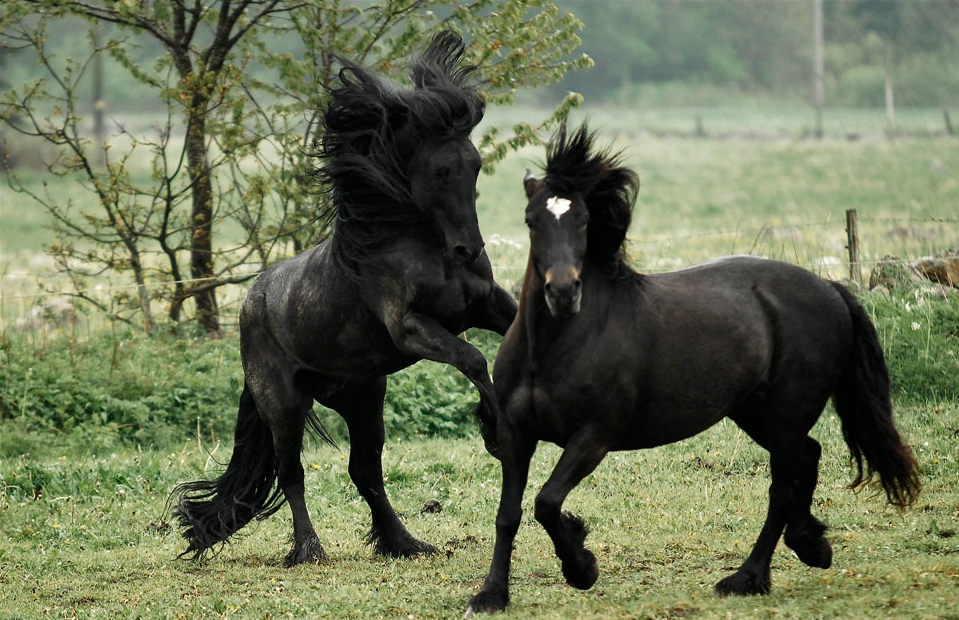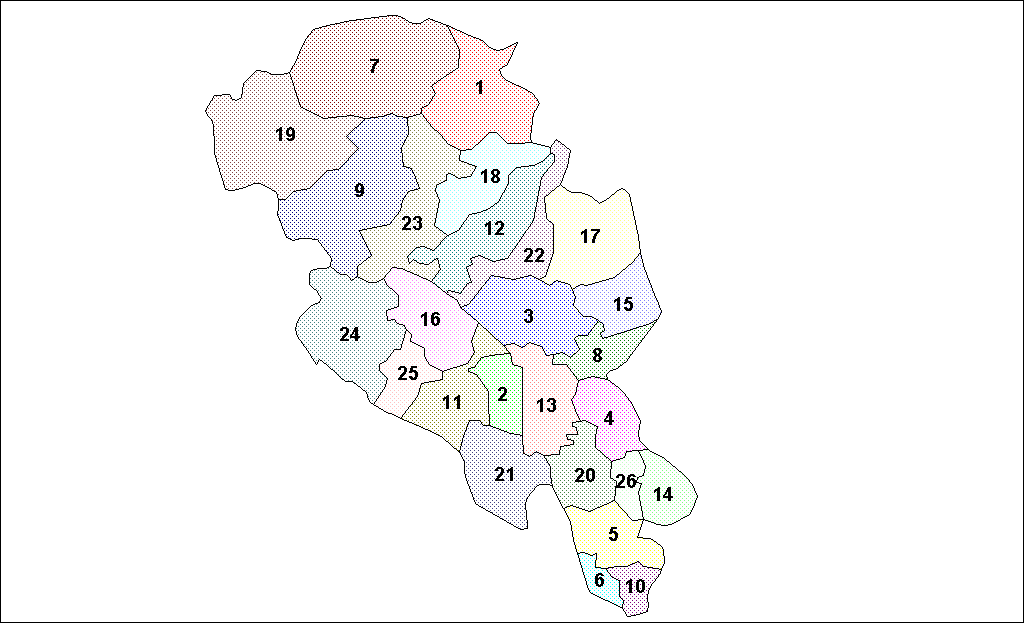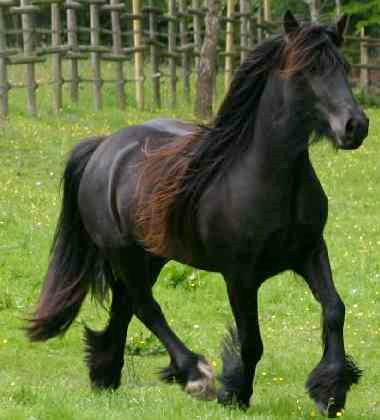|
Dølehest
The Dole Gudbrandsdal, Dølahest, or Dole is a draft- and harness-type horse from Norway. The Dole Trotter is alternately considered a subtype of the Dole Gudbrandsdal and a separate breed; it is also considered a part of the coldblood trotter type. The Dole Gudbrandsdal is a small draft horse, known for its pulling power and agility, while the Dole Trotter is a smaller, faster horse used for harness racing; the two types are commonly interbred. Both types are strictly critiqued before entry into the studbook, which has over time resulted in an improvement in the breed type. The Dole is originally from the Gudbrandsdal Valley, and is probably descended in part from the Friesian horse. Over time, the breed has had Thoroughbred, Arabian, and other breeds added in, especially during the creation of the Dole Trotter in the 19th century. The first studbook was created in 1941, and the current breed association was formed in 1947. Although originally used mainly as a pack horse, to ... [...More Info...] [...Related Items...] OR: [Wikipedia] [Google] [Baidu] |
Draft Horse
A draft horse (US), draught horse (UK) or dray horse (from the Old English ''dragan'' meaning "to draw or haul"; compare Dutch ''dragen'' and German ''tragen'' meaning "to carry" and Danish ''drage'' meaning "to draw" or "to fare"), less often called a carthorse, work horse or heavy horse, is a large horse bred to be a working animal doing hard tasks such as plowing and other farm labor. There are a number of breeds, with varying characteristics, but all share common traits of strength, patience, and a docile temperament which made them indispensable to generations of pre-industrial farmers. Draft horses and draft crossbreds are versatile breeds used today for a multitude of purposes, including farming, draft horse showing, logging, recreation, and other uses. They are also commonly used for crossbreeding, especially to light riding breeds such as the Thoroughbred, for the purpose of creating sport horses of warmblood type. While most draft horses are used for driving, they c ... [...More Info...] [...Related Items...] OR: [Wikipedia] [Google] [Baidu] |
North Swedish Horse
, country = Sweden , distribution = , use = and eventing and dressage , colour = any , height = 152–158 cm , male_height = average 157 cm , female_height = average 154 cm , weight = 550–750 kg , male_weight = average 700 kg , female_weight =average 600 kg , status = FAO (2007): not at risk , note = , group1 = , std1 = The North Swedish Horse ( sv, 'Nordsvensk Brukshäst') is a Swedish breed of small heavy horse. It is closely related to the similar Dølehest breed of Norway. It was traditionally used for forestry and agricultural work. Lighter lines are bred for harness racing, and are registered in the stud-book of the Svensk Kallblodstravare (Swedish Coldblood Trotter). History and breeding Nowadays, breeding of the North Swedish Horse is strictly controlled, and the animals intended for breeding are thoroughly tested. The primary qualities desired in a breeding ... [...More Info...] [...Related Items...] OR: [Wikipedia] [Google] [Baidu] |
Dun Gene
The dun gene is a dilution gene that affects both red and black pigments in the coat color of a horse. The dun gene lightens most of the body while leaving the mane, tail, legs, and primitive markings the shade of the undiluted base coat color. A dun horse always has a dark dorsal stripe down the middle of its back, usually has a darker face and legs, and may have transverse striping across the shoulders or horizontal striping on the back of the forelegs. Body color depends on the underlying coat color genetics. A classic "bay dun" is a gray-gold or tan, characterized by a body color ranging from sandy yellow to reddish brown. Duns with a chestnut base may appear a light tan shade, and those with black base coloration are a smoky gray. Manes, tails, primitive markings, and other dark areas are usually the shade of the undiluted base coat color. The dun gene may interact with all other coat color alleles. Taxonomic distribution Dun is believed to be the ancestral or wild type ... [...More Info...] [...Related Items...] OR: [Wikipedia] [Google] [Baidu] |
Norwegian Trotting Association
The Norwegian Trotting Association ( no, Det Norske Travselskap, DNT) is the sports federation organizing horse racing in Norway. It is an umbrella for the 13 regional federations and 185 local chapters with 17,000 members. Tote betting takes place at eleven harness race courses and one gallop races course, Øvrevoll Galoppbane, all owned by the association. The betting is organized through the association-owned company Norsk Rikstoto. In 2009 the association organized 556 race days, with 4,652 races taking place in 2008. It organizes 5,500 active racehorses, 200 professional trainers, 60 assistant trainers and 3,000 amateur trainers. Horse racing in Norway has traditionally taken place on frozen lakes and home from church on Sundays. DNT was established in 1875. In 1928 horse betting was legalized and Bjerke Travbane in Oslo Oslo ( , , or ; sma, Oslove) is the capital and most populous city of Norway. It constitutes both a county and a municipality. The municipal ... [...More Info...] [...Related Items...] OR: [Wikipedia] [Google] [Baidu] |
Foundation Bloodstock
Foundation bloodstock or foundation stock refers to animals that are the progenitors, or foundation, of a breed or of a given bloodline within such. Many modern breeds can be traced to specific, named foundation animals, but a group of animals may be referred to collectively as foundation bloodstock when one distinct population (including both landrace breeds or a group of animals linked to a deliberate and specific selective breeding program) provides part of the underlying genetic base for a new distinct population. Terminology The terms for foundation ancestors differ by sex, most commonly "foundation sire" for the father and "foundation dam" for the mother. Depending upon the species in question, more specialized terms may be used, such as ''foundation mare'' for female horses, ''foundation queen'' for female cats, or ''foundation bitch'' for female dogs. The offspring of genetically dissimilar parents or stock, whether of different species or different breeds are technica ... [...More Info...] [...Related Items...] OR: [Wikipedia] [Google] [Baidu] |
Norfolk Trotter
The Norfolk Trotter is a historical horse breed once native to East Anglia and Norfolk, England. It was said to be "a large-sized trotting harness horse originating in and around Norfolk". In 1542, King Henry VIII required the wealthy to keep a specified number of trotting-horse stallions. The breed was well established in Norfolk, and later became known as the Norfolk Trotter. The most influential sire in its history is the half-bred stallion Shales (foaled 1755), also known as "Old Shales". Shales' Thoroughbred sire, Blaze (foaled 1733), was a son of the great racehorse Flying Childers (a descendant of the Darley Arabian, one of the three foundation sires of the Thoroughbred). The Norfolk Trotter became the all-around travel horse in England at this time. In Yorkshire, the same breed was known as the Yorkshire Trotter. Both breeds were also known as roadsters. The term Norfolk/Yorkshire Roadster/Trotter is seen commonly in breed-history books; regardless of the name, all are th ... [...More Info...] [...Related Items...] OR: [Wikipedia] [Google] [Baidu] |
Frisians
The Frisians are a Germanic ethnic group native to the coastal regions of the Netherlands and northwestern Germany. They inhabit an area known as Frisia and are concentrated in the Dutch provinces of Friesland and Groningen and, in Germany, East Frisia and North Frisia (which was a part of Denmark until 1864). The name is probably derived from frisselje' (to braid, thus referring to braided hair). The Frisian languages are spoken by more than 500,000 people; West Frisian is officially recognised in the Netherlands (in Friesland), and North Frisian and Saterland Frisian are recognised as regional languages in Germany. History The ancient Frisii enter recorded history in the Roman account of Drusus's 12 BC war against the Rhine Germans and the Chauci. They occasionally appear in the accounts of Roman wars against the Germanic tribes of the region, up to and including the Revolt of the Batavi around 70 AD. Frisian mercenaries were hired to assist the Roman invasion ... [...More Info...] [...Related Items...] OR: [Wikipedia] [Google] [Baidu] |
Oppland
Oppland is a former county in Norway which existed from 1781 until its dissolution on 1 January 2020. The old Oppland county bordered the counties of Trøndelag, Møre og Romsdal, Sogn og Fjordane, Buskerud, Akershus, Oslo and Hedmark. The county administration was located in the town of Lillehammer. Merger On 1 January 2020, the neighboring counties of Oppland and Hedmark were merged to form the new Innlandet county. Both Oppland and Hedmark were the only landlocked counties of Norway, and the new Innlandet county is the only landlocked county in Norway. The two counties had historically been one county that was divided in 1781. Historically, the region was commonly known as "Opplandene". In 1781, the government split the area into two: Hedemarkens amt and Kristians amt (later renamed Hedmark and Oppland. In 2017, the government approved the merger of the two counties. There were several names debated, but the government settled on ''Innlandet''. Geography Oppland extend ... [...More Info...] [...Related Items...] OR: [Wikipedia] [Google] [Baidu] |
Studbook Selection
Studbook selection is a process used in certain breeds of horses to select breeding stock. It allows a breed registry to direct the evolution of the breed towards the ideal by eliminating unhealthy or undesirable animals from the population. The removal of individuals from a population is called culling, and does not suggest killing the animal in question. Typically, culls are castrated or they and their offspring are unable to be registered. Registries which implement studbook selection differ from registries which require only two parents of the proper pedigree or registration status. For example, a horse foal with two Thoroughbred parents is almost certainly a Thoroughbred, but a foal with two Oldenburg parents may not be accepted through studbook selection to be an Oldenburg. The pattern of studbook selection varies from nation to nation and registry to registry, but among horse registries, particularly warmblood registries, the general outline includes an inspection of foals b ... [...More Info...] [...Related Items...] OR: [Wikipedia] [Google] [Baidu] |
Dales Pony
The Dales Pony is a British breed of pony or small horse. It originated in, and is named for, the Dales of Yorkshire in northern England. It is one the nine native mountain and moorland pony breeds of the United Kingdom, and belongs to the broader Celtic group of ponies which extends from Portugal and northern Spain to Scandinavia. It was originally a working pony, and its history is closely linked to the history of lead mining in the Dales. A stud-book was established in 1916. It was used extensively by the British Army in both world wars, and during the Second World War came close to extinction. Subsequent conservation efforts have had some success in rebuilding the population, but it is still an endangered breed, and is listed as "critical" by the Rare Breeds Survival Trust. Its qualities include strength, hardiness, stamina, courage, intelligence and good disposition. History Horses have been present and used in the Dales area from early times. Horse remains dating t ... [...More Info...] [...Related Items...] OR: [Wikipedia] [Google] [Baidu] |
Fell Pony
The Fell pony is a versatile working breed of mountain and moorland pony originating on Cumberland and Westmorland farms of northwest England and is used for riding and driving. The breed is closely related to its geographic neighbour, the Dales Pony, but is a little smaller and more pony-like in build. The Fell Pony is noted for hardiness, agility, strength and sure-footedness. Breed characteristics Fell Ponies vary a good deal in weight and size, so ponies may be found to carry almost any rider. The average height of the breed is , and the upper height limit for the breed is . The breed was bred for the unforgiving mountainous environment of Cumbria in north-west England, so they are adaptable to almost any temperate climate. The colours accepted in the breed are black, dark chestnut, bay, grey, and chestnuts (if both parents are registered). Piebalds, and skewbalds are not allowed. A star on the head and/or a small amount of white on or below the hind fetlock is acc ... [...More Info...] [...Related Items...] OR: [Wikipedia] [Google] [Baidu] |
Fertility
Fertility is the capability to produce offspring through reproduction following the onset of sexual maturity. The fertility rate is the average number of children born by a female during her lifetime and is quantified demographically. Fertility is addressed when there is a difficulty or an inability to reproduce naturally, which is referred to as infertility. Infertility is widespread, with fertility specialists available all over the world to assist mothers and couples who experience difficulties having a baby. Human fertility depends on factors of nutrition, sexual behaviour, consanguinity, culture, instinct, endocrinology, timing, economics, personality, way of life, and emotions. Fertility differs from fecundity, which is defined as the ''potential'' for reproduction (influenced by gamete production, fertilization and carrying a pregnancy to term). Where a woman or the lack of fertility is infertility while a lack of fecundity would be called sterility. Demography I ... [...More Info...] [...Related Items...] OR: [Wikipedia] [Google] [Baidu] |







